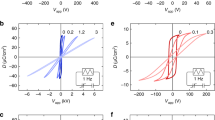Abstract
The ferroelectric domain formation (FDF) and polarization switching (FDPS) subjected to an external electric field are simulated using the phase-field (PF) method, and the FDPS mechanism under different external electric fields is discussed. The results show that the FDF is a process of nucleation and growth in ferroelectric without applying any external stress. Four kinds of parallelogram shaped ferroelectric domains are formed at the steady state, in which the 180° anti-phase domains regularly align along the −45° direction and the 90° anti-phase domains regularly distribute like a stepladder. Steady electric fields can rotate domain polarization by 90° and 180°, and force the orientation-favorite domains and the average polarization to grow into larger ones. The greater the steady electric field, the larger the average polarization at the steady state. In ferroelectrics subject to an alternating electric field, domain polarization switches to cause a hysteresis loop and an associated butterfly loop with the alternating electric field. The coercive field and remnant field are enhanced with the increase of the electric field frequency or strength, or with the decrease of temperature.
Similar content being viewed by others
References
He Y S, Fan J H. A simplified model for domain switching of ferroelectric crystal. Chin J Solid Mech, 2004, 25(4): 371–376
Wang J, Shi S Q, Chen L Q, et al. Phase field simulations of ferroelectric/ ferroelastic polarization switching. Acta Mater, 2004, 52(3): 749–764
Chen L Q. Phase field models for microstructure evolution. Annu Rev Mater Res, 2002, 32(1): 113–135
Nambu S, Sagala D A. Domain formation and elastic long-range interaction in ferroelectric perovskites. Phys Rev B, 1994, 50(9): 5838–5847
Hu H L, Chen L Q. Computer simulation of 90° ferroelectric domain formation in two-dimensions. Mater Sci Eng A, 1997, 238(1): 182–191
Hu H L, Chen L Q. Three-dimensional computer simulation of ferroelectric domain formation. J Am Ceram Soc, 1998, 81(3): 492–500
Wang J, Li Y L, Chen L Q, et al. The effect of mechanical strains on the ferroelectric and dielectric properties of a model single crystal-Phase field simulation. Acta Mater, 2005, 53(8): 2495–2507
Roy K M, Sarkar S, Dattagupta S. Evolution of 180°, 90° and vortex domains in ferroelectric films. Appl Phys Let, 2009, 95(19): 192905
Zhong W L. Ferroelectric Physics. Beijing: Science Press, 1996
Chen L Q, Shen J. Applications of semi-implicit Fourier-spectral method to phase field equations. Compu Phys Commun, 1998, 108(2–3): 147–158
Zhu J Z, Chen L Q, Shen J, et al. Coarsening kinetics from a variable-mobility Cahn-Hilliard equation: Application of a semi-implicit Fourier spectral method. Phys Rev E, 1999, 60(4): 3564–3572
Haun M J, Furman E, Jang S J, et al. Thermodynamic theory of PbTiO3. J Appl Phys, 1987, 62(8): 3331–3338
Stolichnov I, Tagantsev A, Colla E, et al. Kinetics of polarization reversal in ferroelectric films: Role of domain nucleation and domain wall motion. Ceram Int, 2004, 30(7): 1095–1099
Kim J D, Jo J Y, Kim H T, et al. Observation of inhomogeneous domain nucleation in epitaxial Pb(Zr, Ti)O3 capacitors. Appl Phys Lett, 2007, 91(13): 132903
Zhang L Y, Yao X. Dielectric Physics. Xi’an: Xi’an Jiao Tong University Press, 1991
Wang H, Zhu J, Zhang X W, et al. Domain structure of adaptive orthorhombic phase in [110]-poled Pb(Mg1/3Nb2/3)O3-30.5%PbTiO3 single crystal. Appl Phys Lett, 2008, 92(13): 132906
Iwata M, Katsuraya K, Aoyagi R, et al. Domain wall observations and the phase transition in Pb(Zn1/3Nb2/3)O3-8%PbTiO3 by AFM. Ferroelectrics, 2007, 347(1): 157–161
Burnett T L, Comyn T P, Merson E, et al. Electron backscatter diffraction as a domain analysis technique in BiFeO3-PbTiO3 single crystals. IEEE T Ultrason Ferr, 2008, 55(5): 957–962
Yao P, Zhang C L, Xue T, et al. The observation on the electric polarized inversion structure of ferroelectric domain in LiNbO3 crystals with ESEM. Mod Instrum, 2004, 10(5): 23–25
Yang S M, Jo J Y, Kim H T, et al. Ac dynamics of ferroelectric domains from an investigation of the frequency dependence of hysteresis loops. Phys Rev B, 2010, 82(17): 174125
Zheng X J, Lu J, Zhou Y C, et al. Evolution of domain structure and frequency effect on ferroelectric properties in BIT ferroelectrics. Trans Nonferrous Met Soc, 2007, 17(A01): s64–s68
Suryanarayana P, Bhattacharya K. Evolution of polarization and space charges in semiconducting ferroelectrics. J Appl Phys, 2012, 111(3): 034109
So Y W, Kim D J, Noh T W, et al. Polarization switching kinetics of epitaxial Pb(Zr0.4Ti0.6)O3 thin films. Appl Phys Lett, 2005, 86(9): 092905
Ong L H, Musleh A. Tilley-Zeks Model in switching phenomena of ferroelectric films. Ferroelectrics, 2009, 380(1): 150–159
Lohse O, Grossmann M, Boettger U, et al. Relaxation mechanism of ferroelectric switching in Pb(Zr,Ti)O3 thin films. J Appl Phys, 2001, 89(4): 2332–2336
Picinin A, Lente M H, Eiras J A, et al. Theoretical and experimental investigations of polarization switching in ferroelectrics materials. Phys Rev B, 2004, 69(6): 064117
Wu J, Li W F, Huang W B. Micromechanics analysis of the influence of temperature on the process of ferroelectric polarization reversal. Chin J Solid Mech, 2009, 30(4): 341–345
Yuan G L, Liu J M, Baba-Kishi K, et al. Switching fatigue of ferroelectric layered-perovskite thin films: Temperature effect. Mat Sci Eng B-Solid, 2005, 118(1–3): 225–228
Tura V, Ricinschi D, Mitoseriu L, et al. Simulation of switching properties of ferroelectrics on the basis dipole lattice model. Jpn J Appl Phys, 1997, 36(4A): 2183–2191
Tokumitsu E, Tanisake N, Ishiwara H. Partial switching kinetics of ferroelectric PbZrxTi1−x O3 thin films prepared by sol-gel technique. Jpn J Appl Phys, 1994, 33(9B): 5201–5206
Omura M, Adachi H, Ishibashi Y. Simulations of ferroelectric characteristics using a one-dimensional lattice model. Jpn J Appl Phys, 1991, 30(9B): 2384–2387
Author information
Authors and Affiliations
Corresponding author
Rights and permissions
About this article
Cite this article
Zhou, G., Wang, Y., Liu, C. et al. On ferroelectric domain polarization switching mechanism subject to an external electric field by simulations with the phase-field method. Sci. China Technol. Sci. 56, 1129–1138 (2013). https://doi.org/10.1007/s11431-013-5135-3
Received:
Accepted:
Published:
Issue Date:
DOI: https://doi.org/10.1007/s11431-013-5135-3




